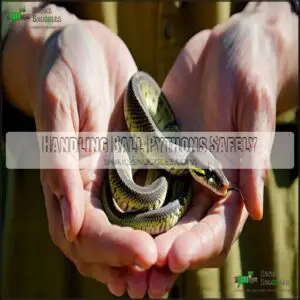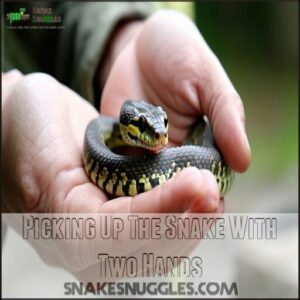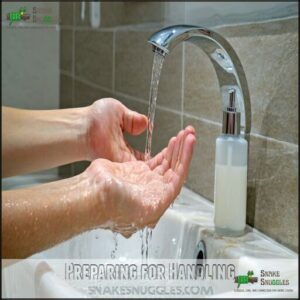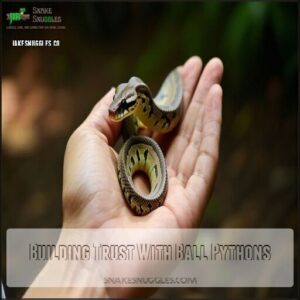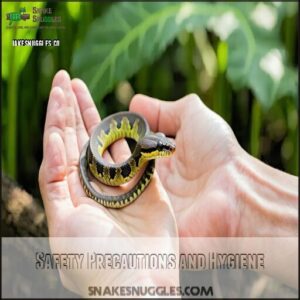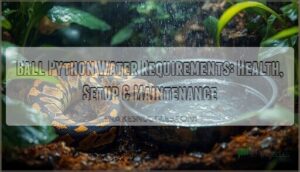This site is supported by our readers. We may earn a commission, at no cost to you, if you purchase through links.
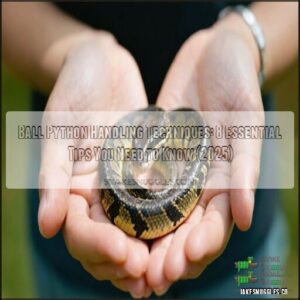 Handling a ball python is all about patience and precision. Always wash your hands first—your snake doesn’t want to mistake your fingers for snacks.
Handling a ball python is all about patience and precision. Always wash your hands first—your snake doesn’t want to mistake your fingers for snacks.
Approach calmly, avoiding sudden moves, and use two hands to support its body evenly. A firm but gentle grip keeps it secure without causing stress.
Timing matters too—skip handling right after feeding or when your snake is shedding; they’re moody then. Pay attention to body language: a relaxed snake explores, while tight curls or hissing signal discomfort.
Creating a smooth handling routine builds trust, and who wouldn’t want a snake buddy that’s chill and cooperative?
Table Of Contents
- Key Takeaways
- Handling Ball Pythons Safely
- Ball Python Handling Techniques
- Avoiding Handling Stress
- Handling Frequency and Duration
- Preparing for Handling
- Recognizing Ball Python Behavior
- Building Trust With Ball Pythons
- Safety Precautions and Hygiene
- Frequently Asked Questions (FAQs)
- How do you handle a ball python?
- How do you train a ball python?
- Can a ball python be handled too much?
- Can a ball python hold and play?
- Can you pick up a ball python by its tail?
- How do you care for a ball python?
- How do ball pythons like to be handled?
- How to tell if a ball python is comfortable with you?
- What is the best way to handle a python?
- How to bond with a ball python?
- Conclusion
Key Takeaways
- Wash your hands with fragrance-free soap before handling to protect your snake and avoid confusion with food scents.
- Always support your snake’s body evenly with both hands to keep it secure and comfortable.
- Avoid handling your ball python after feeding or during shedding to reduce stress and potential health issues.
- Watch for defensive signals like hissing or striking posture, and respect your snake’s boundaries to ensure stress-free interactions.
Handling Ball Pythons Safely
You’ll need to master proper handling techniques to keep both you and your ball python comfortable and stress-free during interactions.
Proper support of your snake’s body, combined with clean hands and a calm approach, will help you build trust with your scaly friend while preventing defensive behaviors, ensuring a positive experience for both you and your pet, with proper support being crucial.
Washing Hands Before Handling
Washing your hands before handling your ball python isn’t just good practice—it’s essential for preventing zoonotic diseases that can spread between reptiles and humans.
Proper handwashing protects both you and your ball python, ensuring safe, stress-free interactions while preventing the spread of zoonotic diseases.
Proper hand hygiene protects both you and your scaly friend.
Here’s what to remember:
- Use mild, fragrance-free soap to avoid irritating your snake’s sensitive skin
- Avoid scented soaps that might stress your python or mask your natural scent
- Scrub thoroughly for at least 20 seconds, including under your nails
- Hand sanitizer works in a pinch but let it dry completely before handling
- Pay special attention to nail hygiene as bacteria often hide there
Using the right kind of soap is vital for reptile safety. Proper hand washing is a simple yet crucial step in maintaining a healthy environment for your pet, emphasizing the importance of good practice and hand hygiene.
Approaching The Snake Calmly
Now that your hands are clean, it’s time to approach your ball python.
Move slowly and stay in its line of sight to reduce stress. Gentle movements build confidence between you and your snake.
| Approach Method | Result | Stress Level | Recommended |
|---|---|---|---|
| Quick grabbing | Defensive strike | Very high | Never |
| Slow side approach | Calm acceptance | Low | Always |
| From above | Fear response | High | Avoid |
| Visual contact first | Trust building | Minimal | Best practice |
Supporting The Snake’s Body
Your ball python’s comfort depends entirely on proper support.
Proper support is the foundation of trust, ensuring your ball python feels secure, relaxed, and ready to bond.
Always provide a secure yet gentle grip that allows natural coiling while preventing injury.
Support the snake’s body weight evenly across your hands and forearms, avoiding dangling sections.
With the midbody hold technique, you’ll create a stable platform where your snake feels secure, not restricted.
Remember, proper snake grip means finding that sweet spot between too loose and too tight, which is crucial for the snake’s comfort and safety, ensuring a secure environment.
Ball Python Handling Techniques
You’ll master handling your ball python with confidence using these proven techniques that prevent stress and build trust.
Proper holds like the mid-body support technique guarantee your scaly friend feels secure while allowing you to safely guide their movements during your bonding sessions.
Mid-Body Hold Method
Now that you know the safety basics, let’s talk about the mid-body hold technique—your go-to method for handling ball pythons.
Place your hand firmly around the middle third of your snake’s body, using gentle but secure grip strength.
Proper hand placement prevents injury while providing adequate body support, and this technique gives your python security while allowing natural movement.
Most ball pythons respond well to this balanced approach to handling.
Using a Paper Towel Roll Signal
Before grabbing your ball python, try using a paper towel roll to gently tap or touch the snake’s head. This signals your intention to handle them and prevents startling your pet.
A creative use of similar technology could involve detecting emptiness using sensors.
- The gentle tapping mimics natural branch movements, helping the snake recognize handling time
- Different ball pythons may respond uniquely—some need just a light touch, others require several taps
- Empty cardboard tubes work perfectly and keep your hands at a safe distance, which is a safe and practical approach to handling your pet.
Picking Up The Snake With Two Hands
Mastering the two-handed technique guarantees your ball python feels secure during handling sessions.
Always support your snake with both hands: one behind the head (not on it) and one supporting the body weight.
| Position | Grip Type | Purpose |
|---|---|---|
| Behind head | Gentle hold | Directional control |
| Mid-body | Secure grip | Main support |
| Tail area | Loose support | Balance weight |
This gentle lift prevents injuries and builds trust with your pet, ensuring a safe and comfortable handling experience with secure support.
Avoiding Handling Stress
Reducing stress while handling your ball python is essential for its well-being and your safety.
By understanding when to avoid handling, like after feeding or during shedding, you can help your snake feel calm and secure.
Avoiding Handling After Feeding
After feeding, your ball python needs time for its digestive process.
Handling too soon disrupts digestion, leading to a regurgitation risk, which is stressful for the snake and unpleasant for you!
Stick to a handling timeline—wait 48-72 hours to guarantee their feeding schedule aligns with safe handling.
Respect digestion to maintain a happy, healthy snake, and remember that patience truly pays off to ensure a happy, healthy snake.
Not Handling During Shedding
After feeding, ball pythons need time to digest, but shedding comes with its own challenges too.
During shedding, their skin sensitivity increases, making them feel vulnerable, and it’s best to delay handling until shedding signs—like dull scales—clear up.
For proper acclimation, let your snake rest during this process, as stress-free shedding means happier, healthier ball python handling overall, promoting a happier and healthier pet.
Recognizing Stress Indicators
Spotting stress signs in snakes, like refusal to feed, rapid breathing, or poor shedding, is essential for healthy handling.
Aggressive behavior or regurgitation signs mean your ball python’s uneasy. Watch for restless movements or defensive postures.
Snake stress is real—overhandling or ignoring stress handling precautions can harm their well-being. Pay attention to snake behavior for smoother interactions, as healthy handling is crucial!
Handling Frequency and Duration
You’ll need to balance how often and how long you handle your ball python to keep it happy and stress-free.
Too much handling can make your snake anxious, while too little can make taming harder.
Handling Adult Ball Pythons
Handling adult ball pythons requires care, especially given their calmer temperament but potential bite risk.
Stick to these safe snake handling techniques:
- Handle 1-3 times weekly, based on feeding schedules.
- Lift from the mid-body to guarantee comfort.
- Avoid enclosure handling immediately after feeding.
Watch for ball python behavior like hissing or striking, and be aware of the importance of post-handling care, which includes washing hands thoroughly.
Handling Young Ball Pythons
Young ball pythons, like fragile hatchlings, require patience and a gentle approach.
Begin weekly handling only after they’ve settled and fed well. Keep sessions short, around 5-10 minutes, to respect their defense mechanisms.
These baby snakes thrive with trust-building handling techniques, so move calmly, avoid sudden movements, and observe their behavior for stress cues during snake handling.
It’s also best to avoid handling them right after feeding to prevent potential regurgitation issues due to potential health risks.
Keeping Handling Sessions Short
Keep ball python handling sessions short to guarantee comfort and minimize stress.
Aim for 10-30 minutes, observing behavior closely during the interaction.
Session frequency matters—handle adults 1-3 times weekly, and avoid overhandling to prevent agitation.
Consider digestive considerations, waiting 48 hours after feeding.
Proper handling techniques and duration build trust while promoting the snake’s well-being.
Always prioritize calm, steady movements.
Preparing for Handling
Before handling your ball python, wash your hands with gentle, fragrance-free soap to remove any food or strong odors.
Creating a calm, quiet environment helps your snake stay relaxed and comfortable during the interaction.
Washing Hands With Gentle Soap
Start each snake handling session with clean hands to protect both you and your ball python.
Use fragrance-free soap with natural ingredients, avoiding anything harsh that could irritate scent-sensitive reptiles. For those with sensitive skin, fragrance-free options abound.
Stick to lukewarm water for comfortable cleansing, and skip antiseptic alternatives unless advised. Dry thoroughly—wet hands can surprise snakes, making reptile handling smoother and stress-free.
It’s simple, yet essential!
Creating a Calm Environment
A calm environment sets the stage for stress-free snake handling.
Minimize noise, dim the lighting, and guarantee a secure enclosure nearby to make your ball python feel safe.
Gradual introduction and a predictable routine help your snake associate handling with comfort, not chaos.
Remember, peaceful surroundings keep your python’s stress levels low, making handling smoother for both of you.
Avoiding Strong Scents
Strong smells can overwhelm a ball python’s sensitive olfactory sense. Before handling, avoid scented soaps, sanitizer smells, or food odors lingering on your hands.
Here’s how to guarantee safer interactions:
- Wash hands with fragrance-free soap.
- Skip perfume or lotions.
- Avoid handling after cooking aromatic foods.
- Allow scent familiarization by letting your snake recognize your natural scent.
Regular enclosure cleaning is key to minimizing odors. You can also manage smells by ensuring proper airflow techniques to create a safer environment for your pet, promoting a healthy relationship and maintaining a clean space.
Recognizing Ball Python Behavior
Understanding your ball python’s behavior helps you handle it safely and confidently. Pay attention to its body language, as it reveals whether the snake feels calm, curious, or defensive.
Signs of a Relaxed Ball Python
A relaxed ball python shows smooth movements, and its tongue flicking often signals curiosity.
Watch for loose coiling, indicating comfort, and calm breathing instead of rapid or heavy exhales.
Understanding snake body language helps gauge snake calmness; relaxed ball python behavior includes exploring gently without defensive postures.
A key indicator is smooth, shiny scales, reflecting proper hydration and care, which are signs of trust, making handling more enjoyable.
Defensive Behavior Indicators
Recognizing defensive ball python behavior keeps you safe and stress-free.
Look for these signs:
- Hissing signals: A loud hiss says, “Back off, I’m uncomfortable.”
- Striking posture: An “S”-shaped curve means it’s ready to defend.
- Elevated body: A raised head and neck signal alertness.
- Refusal feeding or regurgitation risk: Stress can spoil meals.
Stay cautious and respect their boundaries!
Understanding Body Language
Reading your ball python’s body language isn’t as tricky as it sounds.
Relaxed postures like a coiled body or slow tongue flicking mean it’s calm.
Defensive signals, like hissing or head retraction, reveal discomfort.
Here’s a cheat sheet:
| Behavior | Signal | Meaning | Action Needed |
|---|---|---|---|
| Relaxed Posture | Smooth coiling | Calm and content | Continue handling |
| Tongue Flicking | Slow, rhythmic flicks | Curiosity | Let it explore |
| Head Retraction | Hiding head | Feeling defensive | Handle gently |
| "S" Shape | Neck in "S" curve | Ready to strike | Avoid handling |
The table provides a clear guide to understanding your ball python’s behavior, including when it is feeling defensive or ready to strike, helping you to take appropriate action to ensure both you and your pet remain safe and comfortable.
Building Trust With Ball Pythons
Building trust with your ball python starts with patience and consistent, gentle handling. Move slowly, let the snake explore, and give it time to feel secure in your presence.
Starting Handling Inside Enclosure
Building trust starts inside the ball python enclosure. Begin snake handling with patience and care to encourage acclimation and reduce stress.
- Wait 1-2 weeks for initial acclimation.
- Let the snake crawl onto your hand for gradual introduction.
- Use scent familiarization by placing your hand gently inside.
- Offer positive reinforcement with calm, quiet interaction.
To minimize stress, make certain the enclosure provides adequate hiding spots. Make certain minimal disturbance for better snake trust, which is crucial for successful handling.
Moving Slowly and Allowing Exploration
Slow and steady wins your ball python’s trust.
After introducing handling, allow them to explore at their pace. A gentle approach, coupled with supervised exploration, helps them feel safe and curious.
Keep movements smooth and avoid startling them. Gradual introduction builds confidence in both you and your snake, turning handling techniques into a bonding experience they’ll appreciate, which is why slow and gentle movements are crucial.
Consistency and Patience in Handling
After allowing exploration, focus on consistent interactions to build trust. Patience is key; your ball python thrives on familiarity and calm handling.
- Practice regular interaction to reinforce positive behavior.
- Use gradual progression, starting with short sessions.
- Avoiding setbacks like quick movements fosters long-term handling success.
Trust grows with time, so stay steady and let your snake feel secure in your hands, which is crucial for consistent interactions.
Safety Precautions and Hygiene
When handling a ball python, your safety and the snake’s well-being depend on proper hygiene and thoughtful precautions.
Wash your hands, supervise children, and stay alert to avoid accidents or unnecessary stress, focusing on proper hygiene.
Supervising Children During Handling
Supervised interaction is key in regards to snake safety for kids.
Always keep an eye on them during ball python handling, offering clear instructions. Younger children may not understand the importance of gentleness, so your role guarantees bite prevention and safe handling.
Parental guidance helps foster age-appropriate snake supervision, keeping both the child and your python happy and stress-free.
Avoiding Handling After Meals
After meals, your ball python needs time for proper digestion.
Handling after feeding can trigger regurgitation risks and stress, disrupting its digestion timeframe.
Imagine trying to jog after a big meal—it’s uncomfortable!
Stick to safe handling techniques by waiting 48-72 hours.
This avoids the snake mistaking you for prey due to heightened feeding response, ensuring a stress-free experience for both.
Cleaning Bite Wounds and Respecting Boundaries
If your ball python bites, it’s no reason to panic—cleaning bite wounds properly keeps things safe.
Assess bite severity, wash gently with soap, and disinfect thoroughly.
Here’s how to avoid future bites:
- Recognize cues like hissing or striking posture.
- Respect the snake’s space during shedding or feeding stress.
- Use snake handling precautions for safe interactions.
Remember, setting limits keeps everyone happy and ensures safe interactions.
Frequently Asked Questions (FAQs)
How do you handle a ball python?
Handling a ball python is like greeting an old friend—calm and steady wins the day.
Wash your hands, lift it mid-body for support, avoid sudden moves, and let it explore comfortably.
How do you train a ball python?
Training a ball python isn’t about tricks; it’s about building trust.
Handle it gently and regularly, start slow, and observe its comfort level.
Patience, consistency, and calm movements will help you earn its trust over time.
Can a ball python be handled too much?
Too much handling stresses your ball python, much like constant interruptions frustrate you.
Limit sessions to 1-3 times weekly, under 30 minutes.
Respect their behavior—signs like hissing or hiding mean they need a break.
Can a ball python hold and play?
You can handle and interact with a ball python, but it’s not a playful pet like a dog.
They’re more about gentle handling and exploration, not games—think companionship over playtime thrills!
Can you pick up a ball python by its tail?
Imagine lifting a heavy rope by one end—it’s awkward and risky.
Similarly, never pick up a ball python by its tail.
It stresses the snake, risks injury, and makes handling unnecessarily uncomfortable.
Be mindful!
How do you care for a ball python?
Provide a warm, secure enclosure with consistent heat (78–92°F), proper humidity (50–60%), and hiding spots. Feed pre-killed rodents every 1–2 weeks, clean regularly, monitor shedding, and handle gently to build trust.
How do ball pythons like to be handled?
Picture a calm, coiled snake resting in your hands.
Ball pythons prefer gentle, mid-body support with free movement.
Consistent, stress-free handling builds trust, but avoid sudden motions, strong scents, or over-handling to keep them comfortable.
How to tell if a ball python is comfortable with you?
Your ball python shows comfort if it’s calm, exploring slowly, flicking its tongue, and loosely coiled.
If it’s not hissing, hiding, or stressed, you’re on the right track—just don’t overdo handling!
What is the best way to handle a python?
Handling a python’s like learning a dance—approach calmly, support its mid-body with one hand while the other supports the rest.
Avoid sudden moves, let it explore, and keep sessions under 30 minutes.
How to bond with a ball python?
Start bonding by handling your ball python gently and regularly, allowing it to explore your hands.
Move slowly to avoid startling it, and remain patient—trust builds over time.
Consistency is key for taming these calm reptiles.
Conclusion
Mastering ball python handling techniques isn’t rocket science, but it’s not a grab-and-go game either.
With steady hands, calm movements, and a bit of patience, you can make handling a safe, stress-free experience for both you and your snake.
Pay attention to their body language—it’s a silent cheat sheet. Respect their moods, like skipping post-feeding or shedding days, and you’ll build trust over time.
A happy, cooperative ball python starts with your consistent care and effort.

